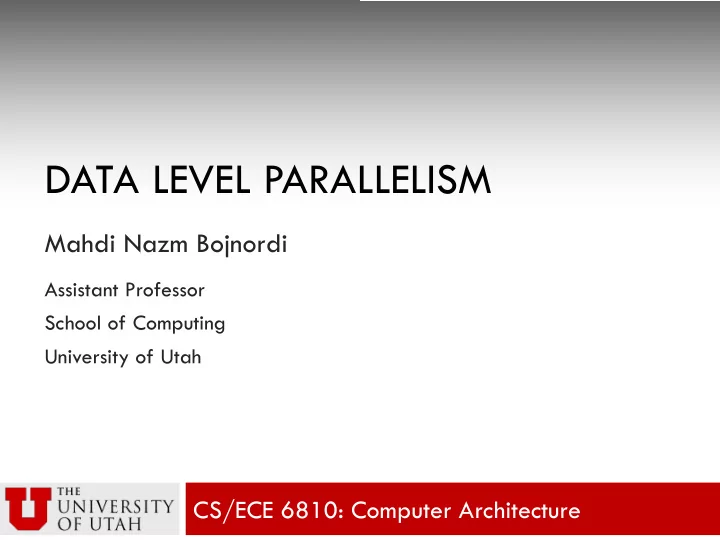

DATA LEVEL PARALLELISM Mahdi Nazm Bojnordi Assistant Professor School of Computing University of Utah CS/ECE 6810: Computer Architecture
Overview ¨ ILP: instruction level parallelism ¤ Out of order execution (all in hardware) ¤ IPC hardly achieves more than 2 ¨ Other forms of parallelism ¤ DLP: data level parallelism n Vector processors, SIMD, and GPUs ¤ TLP: thread level parallelism n Multiprocessors, and hardware multithreading ¤ RLP: request level parallelism n Datacenters
Data Level Parallelism ¨ Due to executing the same code on a large number of objects ¤ Common in scientific computing ¨ DLP architectures ¤ Vector processors—e.g., Cray machines ¤ SIMD extensions—e.g., Intel MMX ¤ Graphics processing unit—e.g., NVIDIA ¨ Improve throughput rather than latency ¤ Not good for non-parallel workloads
Vector Processing ¨ Scalar vs. vector processor } for(i=0; i<1000; ++i) { B[i] = A[i] + x; vadd v3, v2, v1 add r3, r2, r1 } A : … x x x x x x x x x x x + + + + + + + + + + + B : …
Vector Processor ¨ A scalar processor—e.g., MIPS ¤ Scalar register file ¤ Scalar functional units ¨ Vector register file ¤ 2D register array ¤ Each register is an array of registers ¤ The number of elements per register determines the max vector length ¨ Vector functional units ¤ Single opcode activates multiple units ¤ Integer, floating point, load and stores
Basic Vector Processor Architecture
Parallel vs. Pipeline Units
Vector Instruction Set Architecture ¨ Single instruction defines multiple operations ¤ Lower instruction fetch/decode/issue cost ¨ Operations are executed in parallel ¤ Naturally no dependency among data elements ¤ Simple hardware ¨ Predictable memory access pattern ¤ Improve performance via prefetching ¤ Simple memory scheduling policy ¤ Multi banking may be used for improving bandwidth
Vector Operation Length ¨ Fixed in hardware ¤ Common in narrow SIMD ¤ Not efficient for wide SIMD ¨ Variable length ¤ Determined by a vector length register (VLR) ¤ MVL is the maximum VL ¤ How to process vectors wider than MVL?
Conditional Execution ¨ Question: how to handle branches? ¨ Solution: by predication for(i=0; i<1000; ++i) { if ( A [ i ] != B [ i ]) A [ i ] -= B [ i ] ; ¤ Use masks, flag vectors with single-bit elements } ¤ Determine the flag values based on vector compare vld V1, Ra vld V2, Rb ¤ Use flag registers as control vcmp.neq.vv M0, V1, V2 mask for the next vector vsub.vv V3, V2, V1, M0 operations vst V3, Ra
Branches in Scalar Processors inp ALU for (i =0; i < 8; ++i) { if (inp[i] > 0) { y = inp[i] * inp[i]; y = y + 2 * inp[i]; out[0] out[i] = y + 3; } else { y = 4 * inp[i]; out[i] = y + 1; out[1] } … }
Branches in Vector Processors inp ALU T T T T if (inp[i] > 0) { y = inp[i] * inp[i]; y = y + 2 * inp[i]; out[i] = y + 3; } else { T T T T y = 4 * inp[i]; out[i] = y + 1; } out
Recommend
More recommend